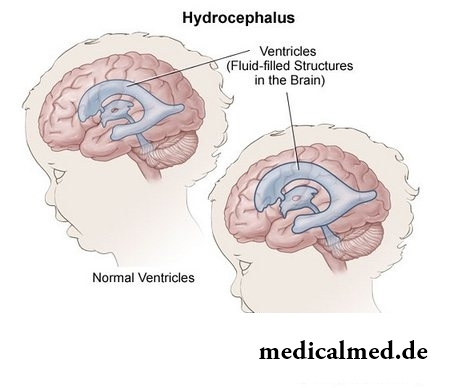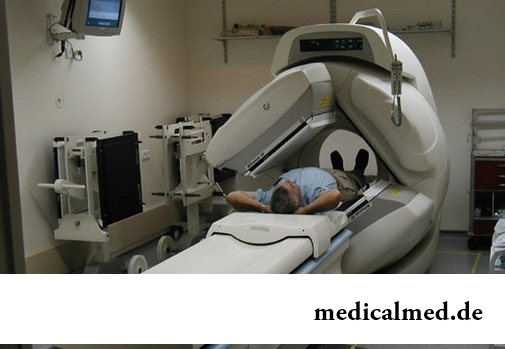





Brain hydrocephaly
General characteristic of a disease

Hydrocephaly of a brain or edema is the neurologic disease caused by accumulation of liquid in ventricular system and subarachnoidal departments of a brain. Hydrocephaly of a brain develops owing to excess production or bad outflow of cerebrospinal fluid (liquor).
To disturbances of circulation of liquor give injuries, infectious and parasitic diseases, tumors or commissures in a brain. And as a result cerebrospinal fluid collects, increases the volume of ventricles of a brain and leads to total magnification of the sizes of a skull, thinning of walls and a rupture of ventricles, and also to problems with sight, paralyzes, epileptic attacks and other complications of hydrocephaly of a brain.
Inborn hydrocephaly of a brain
Brain hydrocephaly at children more often happens inborn. In this case the most terrible complications of the disease which developed during the pre-natal period are observed.
Inborn hydrocephaly of a brain at children is followed by increase in the sizes of the head up to 50% of standard volume. As the frequent reasons of inborn hydrocephaly of a brain at children pathologies of fetation and anomaly of a structure of a brain, the meningitis postponed vnutriutrobno, hemorrhage, etc. act.
Symptoms of inborn hydrocephaly of a brain at children are:
- the capriciousness caused by the increased intracranial pressure;
- small appetite,
- block,
- skin mramornost,
- retraktsiiya of a century (excessive disclosure of an eye),
- preferential direction of a look down.
The acquired hypertensive hydrocephaly of a brain
The tumor, cyst, inflammation or pathological bone changes in a back cranial pole lead to a disease. Hypertensive hydrocephaly of a brain at adults is shown by bilateral frontal and occipital pain, nausea and vomiting, caused by accumulation of cerebrospinal fluid and increase in intracranial pressure. At the same time develop:
- swelled a disk of optic nerves,
- slowness of movements,
- easing of intelligence,
- disturbance of reflexes.
The acquired normotensive hydrocephaly of a brain
At this type of a disease rather normal indicators of intracranial pressure are observed. Provocative factors of normotensive hydrocephaly of a brain are complications after meningitis, subarachnoidal hemorrhage, an injury or aneurism.
Accumulation of liquid in the head leads to pressure upon white matter of a brain, and result develop:
- gait disturbances,
- headache
- weak-mindedness,
- urine incontience.
Not reported and reported types of hydrocephaly of a brain
Not reported or closed brain hydrocephaly at adults or children develops when liquid from ventricles of a brain cannot get to a subarachnoid space. If there is no obstacle in a way of circulation of liquor, the disease is called the reported or open hydrocephaly of a brain. At children both types of a disease are caused by the inborn organic reasons, at adults – the acquired tumors and intracranial cysts.
General, internal and outside hydrocephaly of a brain
Depending on localization of cerebrospinal fluid it is accepted to allocate internal (ventricular), general and outside hydrocephaly of a brain at adults and children.
At an internal form of a disease liquor preferential accumulates in brain ventricles. Outside hydrocephaly is characterized by accumulation of cerebrospinal fluid in a subarachnoid space. And the general or mixed form hydrocephaly of a brain develops at localization of liquor in all cavities of a brain.
Diagnosis of hydrocephaly of a brain
In diagnosis of a disease the computer and magnetic and resonant tomography, an eyeground research, and also a lumbar puncture are used. Diagnosis of hydrocephaly of a brain at children up to 3 years is complicated by need of use of the general anesthesia.
Alternative of KT and MPT in diagnosis of hydrocephaly of a brain at children up to 1,5 years is the neyrosonografiya. Visualization of ventricles and a subarachnoid space by means of NSG is possible only before closing of a big fontanel.
Treatment of hydrocephaly of a brain

Treatment of hydrocephaly of a brain preferential surgical. By means of medicamentous methods it is possible to reach only delay of a course of a disease or to lower intracranial pressure at a gidrotsefalny syndrome. The last is characterized by indirect signs of accumulation of liquor against the background of the increased intracranial pressure and the increased head volumes.
Surgical treatment of hydrocephaly of a brain successfully more than in 85% of cases. By means of the shunting operation perhaps full removal of excess liquor at brain hydrocephaly at adults. The patient recovers completely and restored to normal life. However after a while full or partial replacement of the shunt can be required by him. At brain hydrocephaly at children in connection with growth of the head audit of the shunt is carried out 2-3 times.
Besides, at an inborn form of a disease treatment of hydrocephaly of a brain at children longer is also directed to the maximum correction of inborn complications of a disease.
The priority direction in development of techniques of treatment of hydrocephaly of a brain are low-invasive endoscopic operations. By means of them installation of the shunting system, removal of the cyst blocking outflow of liquor or a tumor is also possible.
In endoscopic treatment of hydrocephaly of a brain the endoscopic ventrikulotsisternostomiya, a septostomiya and an akveduktoplastika are most often applied. They have the minimum percent of post-operational complications and more bystry period of rehabilitation.
During sneezing our organism completely stops working. Even heart stops.

80% of women at least once to lives complained of discomfortable feelings to breasts, consolidations and nagrubaniye. These are mastopathy symptoms. Mas...
Section: Articles about health
Osteoporosis this general disease which main sign is decrease in density of a bone tissue. On distribution width it takes the fourth place among noninfectious diseases. The illness develops at mature age more often: in our country to them harvest seasons...
Section: Articles about health
Maternal milk is the best food for the newborn. It is the unique natural product containing an optimum set of nutrients, and which is best adapted in order that the baby normally developed and it was protected from harmful factors of external environment, unusual for it. Unfortunately, breastfeeding process not always does without complications. Sometimes, that the kid begins to bite a breast, giving to mother an essential inconvenience. Some women...
Section: Articles about health
One of the useful properties presented to the person by the nature is ability to feel fear. This ability is called a signal...
Section: Articles about health
Turnip, radish, horse-radish – once these and other products enjoyed wide popularity at our ancestors, being not only the food sating an organism but also the medicines curing of many diseases. Unfortunately, having given the use of some of them...
Section: Articles about health
It would seem, about it there can be no disagreements: water is necessary for a human body for normal life activity, and about how and when it should be drunk, all know. It turned out that the situation is not absolutely so: for many years there are very persistent delusions connected with this question. Let's consider the most widespread of them....
Section: Articles about health
Practice of hypnotic impact on consciousness of the person contains about two millennia. During this time scientists were in time a lot of things узн...
Section: Articles about health
Physical activity is necessary for normal functioning of a human body. At a lack of the movement joints cease to function, muscles atrophy, cardiovascular activity is broken and the metabolism worsens. Modern городс...
Section: Articles about health
Herpes simplex of the first type (the infectious disease which is shown periodic bubble rashes on lips is called) – one of the most widespread illnesses. Statistically, only 5% of inhabitants of our planet are unreceptive to its activator, and the reasons of this feature are still not found out. Other people are virus carriers....
Section: Articles about health
Milk and products of its processing by right occupy one of the main places in a diet of the modern person. They contain necessary...
Section: Articles about health
According to data of World Health Organization, the cataract is diagnosed almost for 7% of the population of Earth. The statistics of incidence is considered not full as at an initial stage the illness, as a rule, does not cause to the person of special inconveniences, and many having got sick...
Section: Articles about health
The modern person not always manages to find housing in the environmentally friendly region and such work which would not do harm to health. With food stuffs at first sight the situation is much better: shops are overflowed with goods which are positioned by producers as very useful and absolutely safe. Many Russians are absolutely sure that the choice of products with marking "bio", "эко" or "organik" guarantees them and members of their families an optimal variant of food. To a sozhala...
Section: Articles about health
Weakness of an ankle joint – very widespread problem. Its existence is demonstrated by tendency to a podvorachivaniye of legs п...
Section: Articles about health
People know that thermal sources have salutary force long ago. Treatment by natural waters is one of the most ancient methods of disposal of the most different diseases. Bathtubs, souls, wrappings and inhalations, in combination with reception of water vnut...
Section: Articles about health
A little more than a century ago goat milk was a traditional food stuff of most of Russians. Unfortunately, today on tables of our compatriots it appears extremely seldom. The reason that the use of so useful product practically came to naught, not only in very modest volumes of its production and, respectively, rather high cost. Potential consumers are just insufficiently informed on unique properties of goat milk and that advantage which...
Section: Articles about health
The Genetically Modified Organisms (GMO) are plants or animals (as a rule, agricultural) in whose genotype...
Section: Articles about health
Diapers for adults – individual one-time means of hygiene which in some situations is irreplaceable and from such situations any person is not insured. Though nobody perceives need of their use with enthusiasm, however without it to a sra...
Section: Articles about health
Wood louse – the ordinary-looking unpretentious plant extended in all territory of our country. It quickly expands, and sometimes fills sites, bringing a lot of chagrin to gardeners. Perhaps, they would be upset less if knew that the wood louse is valuable medicinal raw materials. A, C and E vitamins, organic acids, tannins, wax, saponins, lipids, mineral salts and essential oils are its part....
Section: Articles about health
All like to sing. Small children with pleasure are engaged in a vocal, not especially thinking of hit in a melody. Adults most often...
Section: Articles about health
Not everyone can brag of the shining Hollywood smile. Even the person who is regularly visiting the stomatologist and watching of oral cavities over health periodically has problems: enamel of teeth darkens under the influence of some products, on it I accumulate...
Section: Articles about health
From sexual contacts each person can test insufficiently strongly expressed sexual desire or lack of satisfaction from time to time. However when it happens regularly, it is an occasion to think about health. Most of people does not hurry to ask similar questions physicians: one consider that they will be able to cope with malfunctions independently, others hesitate to report to strangers about so delicate problems and hope that troubles will stop by itself....
Section: Articles about health
Any of us is not insured from a heavy illness of the loved one. Happens and so that someone from family members becomes lying бо...
Section: Articles about health
Helminthosis is one of the most widespread diseases. Statistically, any species of helminths infected every third inhabitant of the planet. Most of specialists even consider these data strongly underestimated: some uninvited "cohabitants" of N...
Section: Articles about health
Almost each of us during life faced dissatisfaction with own body. At such moments, as a rule, we begin to shame ourselves, urgently we go on the most rigid diet promising minus of 10 kg in a week, or we exhaust ourselves in the gym to almost death. As a rule, similar attempts come to an end with a campaign to the refrigerator for jamming of the next stress. Further history repeats itself with individual frequency....
Section: Articles about health
Ability of an organism to resist to adverse environmental factors (to impact of temperature drops, humidity and pressure...
Section: Articles about health
Extracorporal fertilization – one of the most modern methods of controlling with infertility. So far he already helped a significant amount of married couples to become happy parents. Usually to the EKO procedure difficult and very expensive, resort in those...
Section: Articles about health
The nature does not stand stagnation and monotony. It is known that tissues of a human body atrophy if do not receive necessary loadings. It fully belongs also to a cerebral cortex: when it is not given full-time job, it begins to function worse. As a result memory decreases, the person becomes less bright, acquires information more slowly, hardly switches from one thought to another. There are problems at work, difficulties with communication and career development. These it is unpleasant...
Section: Articles about health
